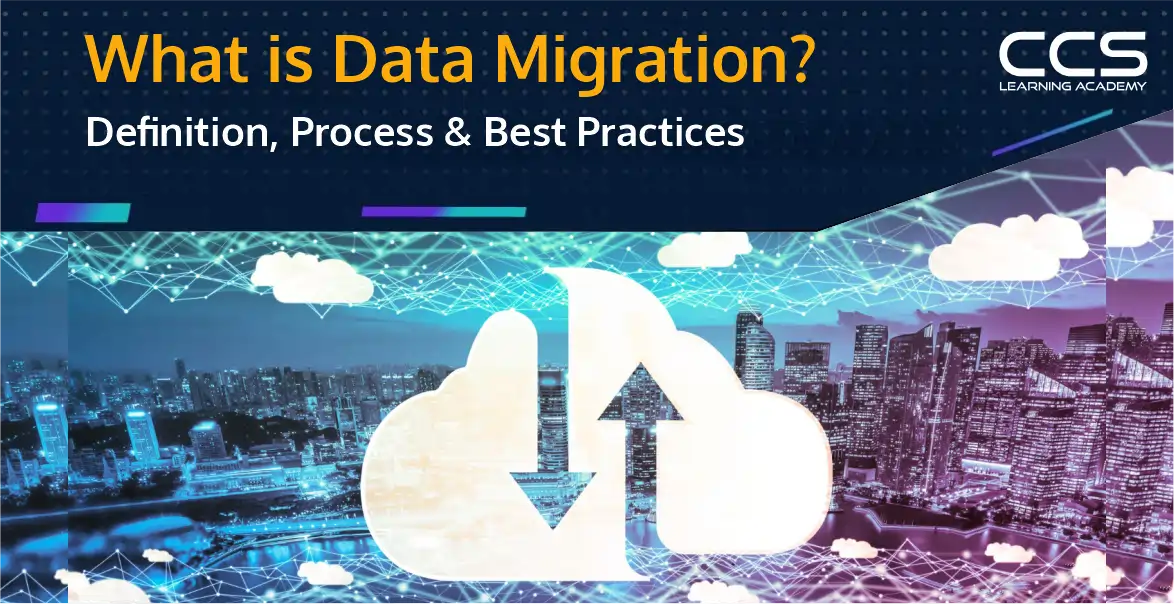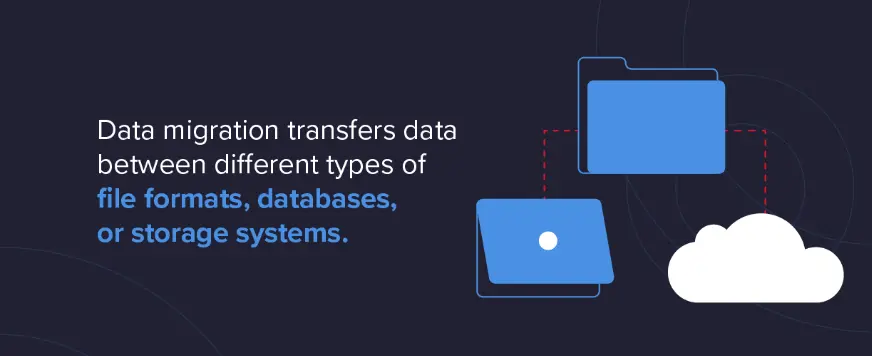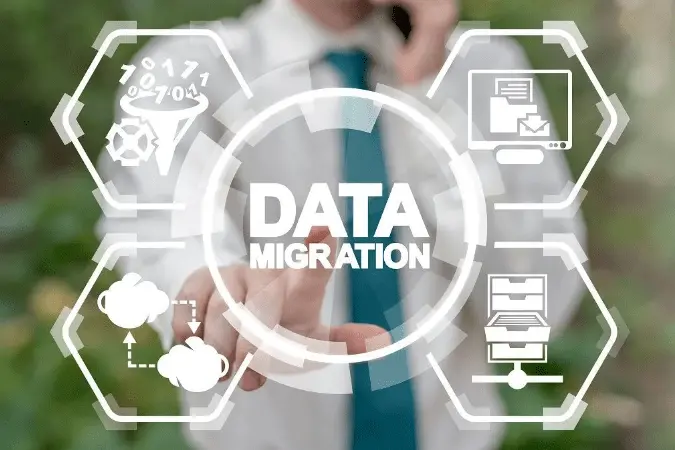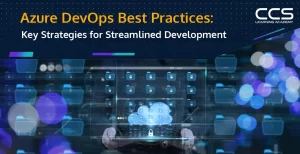What is Data Migration? Definition, Process, and Best Practices
- -
- Time -

Big data is a need of the hour for every organization nowadays. It is a core of digital transformation. To survive and thrive in the industry, every business needs a data migration landscape. To keep up with the influx of data, data migration and integration must be seamlessly executed. With a good data migration strategy, organizations need to be imperative for executive and information technology teams.
Moving data from one destination to another or multiple warehouses for storage to keep the account of full risks and benefits is necessary. Before moving to the process and best practices of this migration system, let’s understand what is data migration and its types.
Understanding Data Migration

It is a one-time process that includes prepping, extracting, transforming, and loading data. A data migration process is used to upgrade databases, deploy a new application, or switch to a cloud-based system. Furthermore, some common scenarios that require data migration are legacy software upgradation, website consolidation, infrastructure maintenance, data center relocation, etc.
Types of Data Migration
When you understand “what is data migration”, it’s time to know its significant types. You can decide on the type that best fits your specific business needs. Some projects, like transferring data to a new CRM system, will require the involvement of teams that rely on the application. Other reasons, like moving from one database to another, can happen without any involvement of the rest of the business or teams. Typically, there are five types of data migration.

1. Database Migration
This data migration refers to either moving data from one database vendor to another or the upgradation of database software to a new version. The data format in this type of migration can vary between vendors so that a transformation process can be performed.
In many cases, any change in database technology does not have any impact on the application layer, but you should get a test to confirm everything is working fine. Furthermore, databases are managed through a centralized database management system (DBMS). Hence, the migration of data becomes accessible to upgrade to the latest version.
2. Business Process Migration
Business process migration requires the transfer of business application data and metrics to a new environment. The metrics include customer, product, and operational information. Data often needs transformation as it moves from one data model to another.
A company reorganization, merger, or acquisition usually triggers these data migrations. Any organization associated with a large-scale business process reengineers initiative. Furthermore, if you wish to understand what is data and cloud migration and learn the popular technical concepts, you can join CCSLA’s Migrating to AWS course.
3. Storage Migration
Storage migration is the process of transferring data from an existing repository to another, often a new repository. The data usually remains unchanged and only gets transferred to another storage location. The goal of executing this storage migration process is to upgrade to more advanced technology that processes data faster and more cost-effectively.
This involves blocks of storage, and files can easily be stored in the system, whether on disk, tape, or cloud. During the migration process, organizations should perform data validation and reduction by identifying obsolete or corrupt data. The lack of space does not drive the transfer; instead, it is a desire to upgrade the storage version.
4. Application Migration
Application migration is another popular type of data migration that is done when an organization wants a change in its software or application vendor. This migration requires moving data from one computing environment to another. A new application may need some radical approach to interact with old version data after migration. The major challenge comes from old and target infrastructures having different models and formats of data.
Application programming interfaces (APIs) are provided mainly by vendors so that you can protect data integrity. Vendor web interfaces may sometimes be scripted, but they facilitate better data migration. Application migration may be a complex process as it has its own models and requires the use of middleware products to bridge the gap of technology.
5. Cloud Migration
Cloud migration concerns the transfer of data from an on-premises location to a cloud-based environment. It is a specific storage migration that IT experts use to witness an increase in cloud migration and start forecasting them for future insights.
The majority of corporations have started operating cloud-based data, and thus, cloud migration has become a common type of data migration. The ‘cloud exit’ process includes migrating data or application processes of a public cloud system back onto on-premises data centers.
Data Migration Process
The data migration process is very systematic and consists of different phases. It starts with planning data profiling and ends with a post-migration audit. To implement an efficient data migration project, you need to assess each stage of its process. Let’s have a look at the data migration process:
1. Planning
Through strategic planning, any business can successfully execute data migration. You can start by assessing the existing datasets and then connecting them to create a plan. To start the planning process precisely, have a better understanding of what is data migration and its requirements.
The planning stage starts by examining the source data and identification of data format, structure, attributes, and location. You should opt for a fitting target storage solution. Before choosing any, analyze the destination system and figure out the source data in the new environment. This needs to be restructured to meet the specifications of the destination.
Further, choose the most suitable approach, either the big bang or the trickle approach, to migrate data. The planning process ends with the allocation of the best-fit resources, set budgets, and defined data transfer timescales.
2. Data Profiling
Before migrating your valuable data, always perform a complete audit of data or profile data critically. Data profiling aims to detect data quality issues like duplicate records, inconsistencies, inaccuracies, and troubleshooting. While data profiling, ensure that you are transferring only high-quality data to the new system. This is where a turnkey data quality solution can be helpful to you.
1. Data Backup
You can keep your data backed up in multiple locations, though it is not obligatory. However, it is a best practice when following the migration process. This will provide extra caution and add layers of protection to your data in case data migration fails.
2. Migration Design
For the migration process, you need to define the proper structure. Start with setting up a destination, performing data mapping, developing testing rules, writing acceptance criteria, assigning migration roles, and specifying data migration methods. You can use several data migration methods that allow you to transfer data from the source to the target destination.
Some of the methods are physical storage migration, backup and restoration, ETL technology, and 1:1 copy (batch EL). Furthermore, there are some data migration tools that you can use: AWS database migration service, Azure data box, custom Python scripts, or Apache NiFi for complex migration needs.
3. Execution and Testings
This is the phase where migration actually takes place after lots of planning and data preparation. A robust data migration process is run through testing to ensure that data is safely transferred and loaded as per the specification.
Several tests and retests are done before the actual migration of data to verify its completeness, reliability, and accuracy. Continuous testing is essential to check if there is any sign of failure in the process and then rectify those issues quickly.
4. Post-migration Audit
After the testing, execution is done. Once execution gets completed, it is crucial to run an audit of migration and check if the results validate the data safety and target infrastructure or not. Once the new system is live and running effectively, you can safely decommission the old environment.
Approaches of Data Migration
The data migration process follows two significant approaches to execute and validate data migration:

Big Bang Data Migration Approach
The Big Bang data migration approach allows you to transfer all associated data within a given time frame. It benefits you by enabling you to create a migration strategy around this method, which includes lower cost, quick move, and less complexity.
The limitation of this approach is that it requires a system that can store data offline, too. There is also a particular risk associated with losing data if the data are not adequately backed up to another location. The implementation of this method means that all systems will be down and unavailable for users during migration. Furthermore, it should be conducted during public holidays or periods when users expect to avoid using this method in the system.
The advantage of this approach offsets the risk of its heavy failure. It can overwhelm the network during transmission. Because of these risks, the Big Bang approach is more suitable for small companies with little data involved in migration. Furthermore, it should not be used on systems that cannot hold large datasets or cannot sustain any downtime.
Trickle Data Migration Approach
The trickle data migration approach is a wholly phased approach that breaks the migration process into various sub-processes. It includes data that is transferred into small increments. The old system remains operational and runs parallel with the migration. The most advantageous aspect of this approach is that it does not have any downtime in the live system, and it becomes less susceptible to errors and failures.
However, with advantage comes limitations. The iterative nature of this process makes it complex and time-consuming. During the whole process of data migration, data should be synchronized well between the old system and the new environment. The trickle migration process is far more ideal for big data organizations that cannot afford any downtime on their systems. Moreover, this approach has less risk of losing data as both old and new systems run at the same time.
Data Migration Best Practices
There are some best practices that you need to observe while conducting a data migration exercise. This ensures the smooth execution of the data migration process with a high degree of success.
Here are some that you should know:
- A dedicated migration team should be established to keep track of the process better. The right specialist in place can manage and steer the project efficiently.
- Data migration is a chance to clean data and increase its quality before it is transferred to another system.
- The amount of data to be migrated should be the correct size. Data cleaning and arranging can assist in ensuring that only quality and beneficial data is migrated to another system.
- All the data should be profiled carefully before writing mapping scripts.
- Remember to backup data before the migration begins to protect your valuable data against data loss.
- Keep testing and retesting the data that is to be migrated. Run data through all the migration phases, like planning, execution, and maintenance, to guarantee the success of the migration process.
- Once you are done with migrating data, you should switch off the old system. Ensure that data transferred to the new system is completed correctly and set. However, if it fails, a roll-back should be done with no downtime, as the old system will still be running or have backup data.
- Build a strategy and stick to it. The data migration process can become complex, and thus, it is the responsibility of data managers to follow the correct strategy and rectify errors.
Conclusion
When it comes to digital transformation, it becomes essential to start a data migration initiative and get your valuable data backed up in a robust network. Nowadays, this has become a necessity rather than a choice or luxury. In terms of data migration, change is always inevitable and has certain risks and considerations.
Treating data migrations as a part of the innovation process is really needed to have a solid grasp of business. Therefore, knowing what is data migration and its best practices is highly significant.
Today, companies are also looking for professionals who are well-versed in technical aspects and have a strong foundation. So, if you want to grab an opportunity to be hired by big companies, you can take advantage of Live Instructor-led Cloud Courses at CCSLA. It offers live assistance, one-to-one mentorship, and placement offers for its learners.
FAQs
Data migration is the process of transferring data from one system to another, which may involve a change from one data storage type, format, or computing environment to another. It is commonly undertaken during upgrades of existing systems, implementation of new systems, or consolidations of data environments.
There are several types of data migration, including storage migration, database migration, application migration, and business process migration. Each type addresses different needs, such as moving from physical to cloud storage, transferring from one database system to another, or updating software applications.
The data migration process typically involves planning, project scoping, data assessment, data cleansing, migration design, execution, and validation. Each step requires careful management to ensure data integrity, security, and compatibility with the new environment.
Common challenges include data loss, prolonged downtime during migration, data corruption, incompatibility issues, and exceeding budgets or timelines. Managing these risks requires thorough planning and testing throughout the migration process.
Preparation should start with a comprehensive audit of the existing data and systems to understand the scope and requirements of the migration. Developing a detailed migration plan, including risk management strategies and a clear timeline, is crucial.
Best practices for data migration include ensuring data quality by cleansing data before migration, using reliable migration tools, conducting thorough testing at every stage, maintaining robust data backups, and ensuring compliance with all data protection regulations.
Tools vary depending on the specific type of migration but can include data integration tools, ETL (Extract, Transform, Load) solutions, database management systems, and specialized migration software that supports large-scale data transfers efficiently.
Minimizing downtime can be achieved by meticulous planning, executing dry runs to identify potential issues, using incremental migration strategies, and scheduling migration during off-peak hours to lessen the impact on operations.
Data security is critical throughout the migration process to protect sensitive information from unauthorized access, corruption, or loss. Implementing strong encryption, access controls, and continuous monitoring are essential to safeguard data during and after migration.
After migration, data validation is essential to ensure that the data is accurately transferred and functional in the new environment. This involves checking data completeness, integrity, and functionality through various testing and audit procedures.






